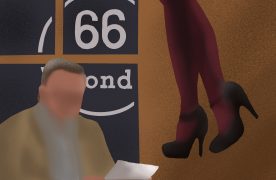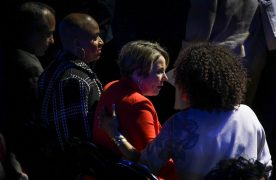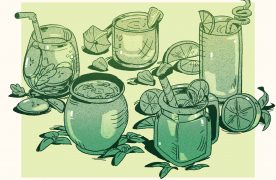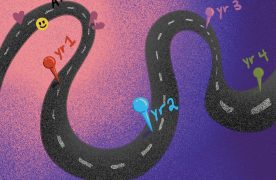By now, you’ve probably heard about Disney’s recent remake of the iconic “Cinderella” film. Originally popularized by Charles Perrault in the late 1600s, “Cinderella” is the quintessential fairytale: downtrodden girl goes to the ball with the help of some woodland creatures, falls in love with a dashing prince and rides off into the sunset. The narrative has been told and retold a thousand times for books, movies and television shows, but Disney’s 1950 version has remained the standard throughout. Now, however, Disney has decided to bring the canon into the 21st century, complete with real actors, a lovely score and computer-generated woodland creatures.
Given the recent trend in revival films — see: every superhero movie from the last few years — it was only a matter of time before fairytales reclaimed their spotlight. With its iconic status, “Cinderella” is a logical first step in this direction. Unfortunately, the reboot brings with it a few themes best left in the past.
By the time “Cinderella” received its 1950 iteration by Disney, it was already a dated concept. In the 17th century where it originated — and, to some extent, in the ‘50s as well — women were valued less for their intelligence and more for their subservience and beauty. Cinderella exemplifies these features perfectly, and because of them, she is swept up by the prince, never to scrub a floor again. She herself does little work to advance the story. She flits from the care of her evil stepmother, to a fairy godmother, and finally, into the arms of the prince. The only thing she had to do on her own was make curfew, and we all know how that turned out.
Dated as it may be, “Cinderella” makes no claims to being an accurate representation of life, and this is not meant as a scathing critique of the tale. The remake, however, seems like a step back for Disney in terms of its influence on children. Recent Disney/Pixar collaborations have featured strong, independent female protagonists, such as Merida in “Brave” and Elsa and Anna in “Frozen.” Even “Tangled,” another elaboration on a centuries-old fairytale, brought itself into the modern age by giving Rapunzel an independent, dynamic personality. Why, then, can’t “Cinderella” do the same?
This is not to say that the “Cinderella” reboot doesn’t make some changes in the right direction. It was necessary for the writers — if only to reach feature-film length — to give Cinderella’s character more of a personality, and they do well with presenting her in a more courageous and self-motivated light. And, as the Harry Potter films have proven, it’s hard not to do well in the box office when you have Helena Bonham Carter yielding a magic wand. As a faithful reincarnation of a classic princess story, the movie is a smash hit. But the Cinderella narrative is a tired one, and it is all too prevalent in today’s non-fairytales as well.
Though the term “Cinderella story” has come to signify any meet-cute romance, the actual notion predates even the Perrault fairytale. It is the standard setting for most fairytales: orphaned teenage girl with plain features and a life of hardship is discovered by a handsome Prince Charming and, with his help, realizes that she is beautiful and also has a personality. Fantastical as it may seem, this idea is not unique to fairytales. It came up in Victorian poetry, Gothic short stories and even modern novels. Think of “Twilight” or the more recent “50 Shades of Grey.” Though one may have inspired the other, both stories are, perhaps unknowingly, based on what we know as the Cinderella story.
It’s safe to say that we’ve come a long way since the days of fairytales. So why are we clinging to the same old idea? We seem to be stuck in the notion that female characters must be patient and passive above all else, and we promise a handsome prince to those who are. In 2015, it’s about time we free ourselves from that ideal. If we’re being honest, “modesty” went out the window a long time ago. I don’t mean literal modesty, which is always a good thing when used sparingly. I’m talking about the kind of “modesty” that women are supposed to emulate at all times, denying their own beauty and intelligence to comfort others — namely, men, who are rarely expected to do the same. This brand of female character has no place in the 21st century, where self-love has become a priority.
We no longer need another person, especially not Prince Charming, to show us that we are spectacular. We never did. The Cheetah Girls knew it in 2003 when they sang, “I don’t want to be like Cinderella/ Sitting in a dark cold dusty cellar.” So, while the new movie might be a charming look into the past, the “Cinderella” story is one best left to fairytales.












I’m tired of pseudo-feminists who attack female characters who are not “strong” and dismiss them as anti-feminists. That makes no sense whatsoever. Grace, patience, and kindness are some of the most amazing attributes for anyone to have, regardless of gender. Just because Cinderella wasn’t some sword wielding, aggressive alpha female (although I love those female characters too, a la Arya Stark) doesn’t make her a weak character, either. She chooses to face her adversity with optimism and forgiveness, and I think that takes a lot more courage than to run away from it all.
The film explained, as well, that she chooses to stay at her family home because the home meant a lot to her parents, so she is staying there for them, not for Lady Tremaine. I don’t see anything wrong with that. She is also smart enough not to physically assault Tremaine and her stepdaughters because she doesn’t want to be kicked out, as women of the time period would not survive as a cast out member of society. In my opinion, Cinderella is like Sansa Stark of Game of Thrones, who uses courtesy as her greatest defense against vile actions of others.